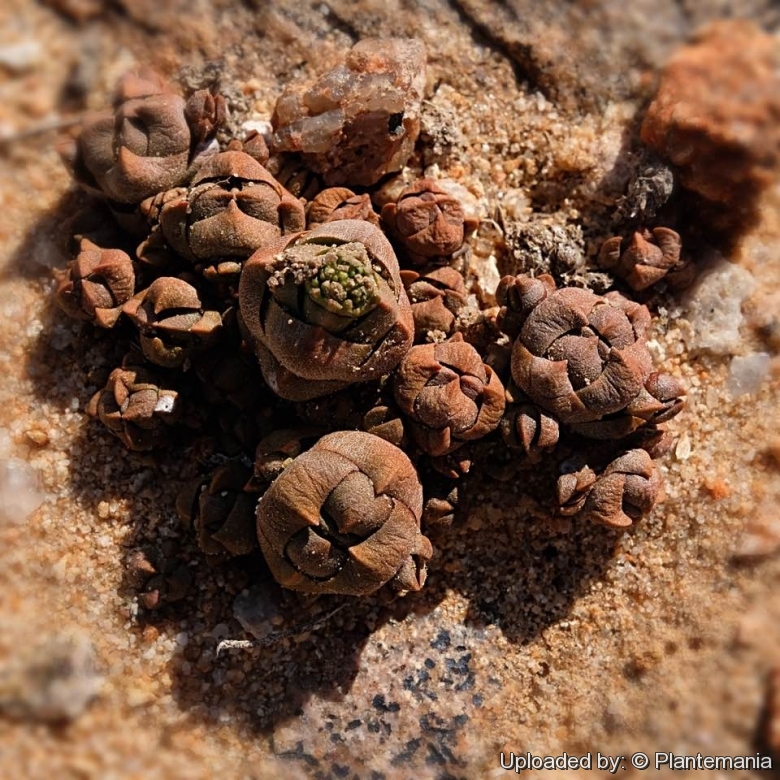
Crassula columnaris subs. prolifera Photo by: © Plantemania
In habitat, Republic of South Africa. Plants are variously coloured to blend in with the harsh, dry and rocky environment in which they grow. But all this fine mimicry is lost when a plant is moved out of its natural environment. Under more humid conditions the typical ball form is modified through the elongation of the stem into a small but erect green column on which the leaves are no longer closely packed but rather loosely arranged.
Origin and Habitat: Crassula columnarisSN|26654]]SN|26654]] subsp. prolifera is the northern form which occurs in Namaqualand, Bushmanland (Northern Cape, Republic of South Africa) and southern Namibia
Habitat and ecology: Succulent Karoo. This species flowers mid-winter to spring (July to October).
Synonyms:
See all synonyms of Crassula columnaris
back
Accepted name in llifle Database:Crassula columnaris subs. prolifera FriedrichMitt. Bot. Staatssamml. München 11: 334 1974Synonymy: 4
Accepted name in llifle Database:Crassula columnaris Thunb.Nova Acta Phys.-Med. Acad. Caes. Leop.-Carol. Nat. Cur. 6: 329, 335. 1778Synonymy: 4
back
Common Names include:
ENGLISH: Leather Button, Shaving Brush
AFRIKAANS (Afrikaans): Sentkannetjie
Description: Crassula columnarisSN|26654]]SN|26654]] subsp. prolifera is much branched at the base. Subsp. prolifera is the northern form in which the axillary buds break off and root around the parent plant, hence the name 'prolifera'. The main stem extends up to 80 mm especially on flowering and the flower cluster is well above the leaves. After flowering the flowering stem dies back (it is monocarpic), but in the leaf-axils of the lowest leaves small new shoots have been developed. This characteristic is the big difference between ssp. prolifera and the standard Crassula columnarisSN|26654]]SN|26654]] which really dies back after their flowers stopped blooming and can therefore only be propagated through seeds. The plants only last for a few years.
Stems: Only 1-2 cm in diameter, proliferating profusely from the base forming dense groups. At time of flowering (early winter) the adult shoot starts to stretch, the leaf pairs take a distance from each other and the compact column looses its beauty a bit.
Leaves: Fleshy, greeny brown, sand brown or blackish colour, arranged in a regular geometric pattern that appears plaited. This happens slowly, gradually forming a column around each stem in mature plants, about 2 cm in diameter. Lower face with a distinct keel. It is the keel or beak on the leaf tips that distinguish this sub species from one another. In habitat the fleshy rosettes, often appears desiccated after a long, hot and dry summer. Even after rain the plant retains some of the brownish leaf colour. In cultivation this Crassula forms lovely fat columns with densely stacked leaves.
Flowers. In winter an awesome inflorescence of few centimetres in diameter is produced. It is covered with whitish flowers which continue to bloom for a long time and sometimes buds are tinged with red or pink. Corolla 6-9 mm.
Blooming season: Mid-winter to spring.
Subspecies, varieties, forms and cultivars of plants belonging to the Crassula columnaris group
- Crassula columnaris Thunb.: plants remain unbranched. Lower keaf-face not keeled, tip rounded. Distribution: Eastern Cape, Northern Cape, Western Cape.
 Crassula columnaris subs. prolifera Friedrich: plants are much branched at the base. Lower leaf-face with a distinct keel. Tip mucronate. Distribution: Namaqualand, Bushmanland (Northern Cape, Republic of South Africa) and southern Namibia.
Crassula columnaris subs. prolifera Friedrich: plants are much branched at the base. Lower leaf-face with a distinct keel. Tip mucronate. Distribution: Namaqualand, Bushmanland (Northern Cape, Republic of South Africa) and southern Namibia.
Bibliography: Major references and further lectures
1) Urs Eggli “Illustrated Handbook of Succulent Plants: Crassulaceae” Springer Berlin Heidelberg, 05/Nov/2012
2) Doreen Court “Succulent Flora of Southern Africa” CRC Press, 01/June/2000
3) “The Illustrated London News”, Volume 223, 2nd Edition, Illustrated London News & Sketch Limited, 1953
4) www.crassula.info Crassula columnaris ssp. prolifera web: http://www.crassula.info/EN/ColumnarisProliferaEN.html
5) Williamson, 2010
6) Vlok and Schutte-Vlok, 2010
7) Judd Kirkel “Crassula columnaris subsp. prolifera” in Operation wild flowers. web: http://www.operationwildflower.org.za/index.php/albums/crassulas/crassula-columnaris-subsp-prolifera-richtersveld-eksteenfontein-judd-2-2709
8) Judd Kirkel Welwitch “Flowering South African Crassula” Xerophilia – Vol. 2, No. 3 (6) – September 2013










